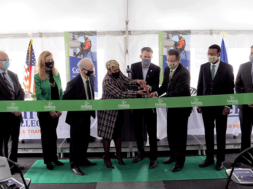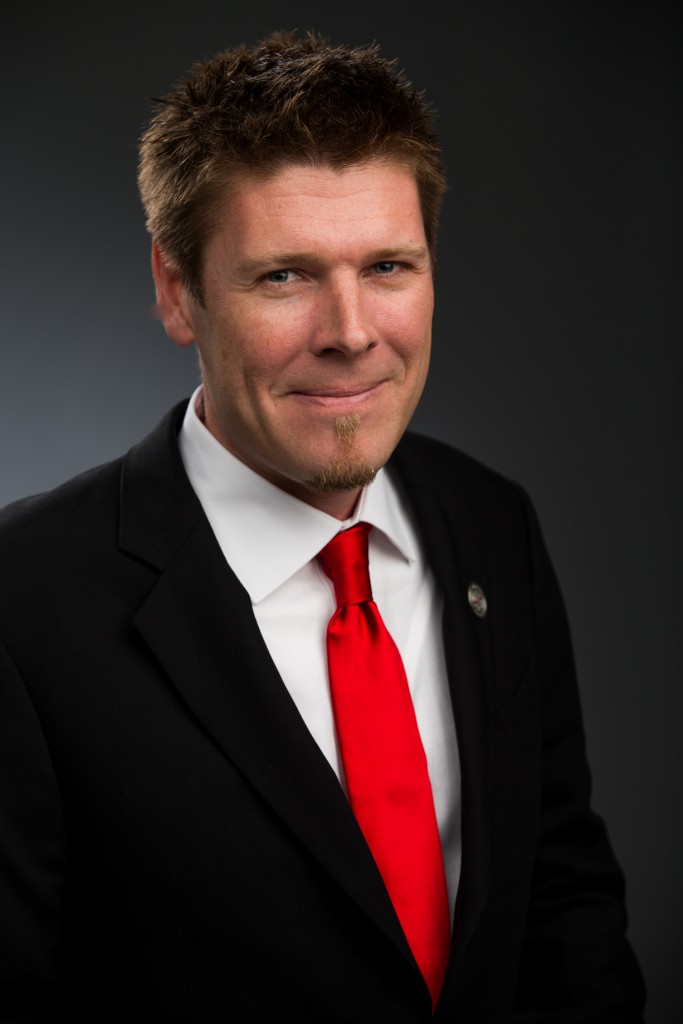
University of Advancing Technology Promotes Programming as Possible Career at Arizona’s Largest Statewide Code Day
Written by Barbara A. Schmitz from an interview by Jenny Faubert with Jason Pistillo, President, UAT
A family-owned technology university became one of the first colleges to significantly promote computer science to young programmers when it served as host for Arizona’s largest Code Day.
The University of Advancing Technology or UAT was one of the first universities to respond to the recent White House initiative, “Computer Science for All,” which aims to “empower all American students from kindergarten through high school to learn computer science and be equipped with the computational thinking skills they need to be creators in the digital economy.”
UAT President Jason Pistillo says Code Day brought 350 young people to their Tempe, Arizona campus for 24 hours in February 2016. “They spent the night and slept in sleeping bags and coded all weekend long,” he says. “They worked on … a coding challenge to create some defined deliverable by the end of the weekend.”
Code Day is a national program supported by Student RND, a nonprofit organization that runs multiple programs to promote STEM education for middle school, high school and college students. It is meant to fill the gap between in-school programs, which explain how to code, and students’ eternal question of why they need to know this. Students start out Code Day by pitching ideas for projects, and then spend the next 24 hours coding the most interesting ideas in small groups. Throughout the event, faculty run small workshops and serve as mentors for students.
For some students, it is the first time they’ve tried coding. Other students are regular coders, however. To make it fair, Code Days breaks the students up by levels so they only compete against students at the same level, Pistillo explains.
The UAT Code Day event was meant to get children as young as 6, 7 or 8 and up to 16 interested in coding, as well as in programming and software projects. “That’s important because there is a big vacuum in computer science-related teaching in the K-12 system,” Pistillo says.
In 2012, only 3 percent of all college students nationwide were studying some sort of technology as their major, he says.
In Arizona, that statistic was only 1 percent.
That means the K-12 system isn’t getting students interested or even aware of the computer science field. And without an interest in computer science in high school, students don’t enroll in computer science programs in college.
“Colleges have the programs, but they are all under-enrolled,” he says. And that creates a big challenge for employers since 50 percent of the new jobs are in high-technology fields, such as software engineering, computer science and cyber security.
“The local industry is talent starved in Arizona; they can’t get enough,” Pistillo says. “They can’t grow. They have plenty of clients who want to buy their products, but they can’t scale their operation because they can’t find talent.”
About UAT
The University of Advancing Technology is the “Julliard of Tech,” says the president of the family-owned private technology university founded in 1983.
Jason Pistillo says UAT is focused on educating students in advancing technology who desire to innovate. They educate students in an exclusively high-tech field that includes things like advancing computer science, information assurance, cyber security and even game development.
Their programs have a long history, Pistillo says. UAT’s game development program started from its virtual reality curriculum that was launched in 1990. “Our cyber security program started before the word ‘cyber’ was coined in 1999,” he adds.
Their residential campus, located in Tempe, Arizona, is home to students from all 50 states, Pistillo says. Its technology infused, urban campus is a technology nexus; a collection of technophiles, tech geeks and mavens of the digital world who evolve into top technology executives, master programmers, cyber warriors, forensic sleuths, robotic engineers, interactive filmmakers and game innovators for entertainment and government animation applications.
For more information, go to http://www.uat.edu/.
To solve this problem in the long term, Pistillo says they need to get children interested in coding in the K-12 system. He blames the No Child Left Behind legislation for part of the problem, since some school programs were canceled so districts could keep all students on track. “For example, in Arizona schools districts, numerous honors and advanced classes were canceled in order to spend the time and resources doing individual education plans for students who were falling behind,” he says. “That, combined with standardized testing, left very little room for anything in computer science.”
While some schools are trying to get innovative and fix that issue, it’s presenting a challenge, particularly because of a general lack of resources.
Pistillo explains: “You’ve got two basic problems: You only have so much room on a student’s high school transcript. Secondly, you only have so much money to spend on resources.”
A principal at a local middle school told him she had an operating budget of $4 million, but she could only control about $30,000 of that budget, he says. “That was all. She had no hiring or firing autonomy. She had no ability to pay faculty.”
Other schools don’t have the money to buy necessary equipment.
Pistillo says UAT donates its four-year-old computers to the nearby East Valley Institute of Technology, a public school that serves students from member high schools. “I donated maybe 800 computers over the last decade, and all of the computers are ones we can’t use anymore because they’re so old,” he says. “Yet these computers are the best computers East Valley has on campus. And that is probably the only school in town that is able to run some of the courses that would get a student interested in what we do.”
That’s why Code Days is so important. “It helps to inspire young people to get into these fields,” he says.
He says he believes events like Code Day are important for two reasons. “One, students are not getting exposed enough (to the field) in K-12,” he says.
For example, he points out that in 2015, 469,689 students took the AP exam for U.S. History, yet only 48,000 took the AP computer science exam. “That’s a problem,” he says.
“What kids get excited about in high school is what they’re going to do immediately following high school,” he says. “It may not be what they’re going to do for the rest of their life, but what they’ve transitioned out of those years they’re going to continue on. So if you don’t turn them on to computer science, they’re never going to get into it. If they don’t get into it, our country is in a lot of trouble.”
Code Days help to educate students about programs or degrees that may interest them in the field, he says. But all jobs in the computer science technology field are currently fast growing, especially cyber security, software engineering, network computer engineering, computer system analyst, data managers or data scientists. “I have 10 jobs for every student that graduates,” Pistillo says. “I can’t enroll enough students to keep up with the job market.”
UAT also expands its programming based on changing technology. About two years ago, for instance, they began a digital maker program that combines the aspects of 3-D printing, rapid prototyping and an easier way to take to market, he says. Then a year ago, they launched Business Tech, a program designed to help tech entrepreneurs.
In fact, UAT’s Board of Directors is currently considering creating its own technology charter high school at its campus. “But if we pursue that, it will still be years out,” Pistillo says. “We realize we have the strategic advantage. Most of our students are nocturnal so why wouldn’t we spend some of our slack time in the day teaching high school kids since we already have the infrastructure and computers. We’re just trying to help solve this job problem.”
For the moment, boot camps are coming on board to also help train people for the advancing technology jobs that are not being filled. “They are short-term programs meant to help fill huge vacuums in the market,” Pistillo says. “But in my opinion, they are overhyped. Most of them aren’t hardcore programming.”
But he also warns that they are expensive – about $10,000 to $15,000.
Most of the boot camps are Web development, he says, and offer continuing education classes online. But the students usually have to bring all their own software and equipment. Boot camps tend to have about 10 hours of delivery spaced throughout the program; the rest is project work mentored by a project master. “Twelve weeks, 10 hours a week of instruction, 30 hours extra of just working on your stuff – that sounds like a lightweight semester at my school,” Pistillo says. “They’re basically taking one semester of your curriculum and really just focusing on one thing…”
But these boot camps are not affiliated with accredited schools, so before students enroll, they need to make sure the outcomes are what they desire and need, he says. “I’ve been hearing rumbling lately that some of them are having major satisfaction issues with students. Students go in and think they’re going to learn to be a software engineer and instead they learn how to be a web developer. In general, you’re not going to become a hardcore software engineer in 12 weeks. There’s just no way.”
Some boot camps are also calling themselves “code academies,” and that is somewhat misleading, Pistillo says.
But despite that, employers are hiring people with only a boot camp educational background.
“Right now most employers in the computer science field have at least 10 job openings,” he says. “They are taking whoever they can get and training them themselves. If you are a web developer, they’ll hire you and train you themselves because they’re starving for talent.”
Pistillo says UAT became involved with events like Code Day after deciding in their 2007-2012 strategic plan that they needed to be more involved, both in local philanthropic organizations and in moving Arizona’s education system forward. While he was the first to get involved, the entire UAT leadership cadre is now active in the local community and serves on nonprofit boards.
“Nine years later, we’re probably one of the most involved small organizations in the Arizona community,” he says. “We’ve won many awards for that, including one as Arizona’s Most Admired Company.”
Being involved is now part of the company’s culture. “If you’re an art professor, I expect you to be on the Art Council, for example,” he says. “We’ve made it part of the expectation and the cultural norm.”
Written by Barbara A. Schmitz from an interview by Jenny Faubert.
Jason Pistillo is one of the youngest seasoned veterans with 22 years of Higher Ed experience you’ll ever meet. He is a second-generation educator steeped in the values of creating higher education opportunities that harness real change and innovation. Jason’s foresight has been hardened in the trenches of operations, as well as tradition, which has empowered him to become a visionary for the next generation.
Jason has implemented innovative educational models and systems, designed real-time curriculum information structures and best-of-class intake systems, developed innovative curriculums, proved new learning theories and developed more young technology leaders along the way than most with twice his seniority. His commitment to lifelong learning, personal growth and development of his stakeholders culminates in his joy of educating future leaders in the fields of advancing technology.
Inspired by his students and long-term work in the industry, Jason also founded Gimrari, a consulting company that creates novel and brazen solutions for industries in need. Edgy, contemporary, fast paced and forward looking, Gimrari has the ability to help companies in any industry cut through their own Gordian Knots.
Jason currently holds a Bachelor of Science in Software Engineering and is a graduate of the Ken Blanchard Executive EMBA program at Grand Canyon University.
A Valley Leadership alumnus, Phoenix Business Journal’s 40 Under 40 award recipient, Chairman Emeritus of the Arizona State Board of Private Post-Secondary Education, Chairman Emeritus of the Leonardo da Vinci Society for the Study of Thinking, member of the Private Education Research Council and Career College Idea Exchange Group, and current Director for the Association of Private Sector Colleges and Universities, Jason has been a noteworthy leader in the industry for more than two decades. In his tenure, University of Advancing Technology (UAT) has been transformed into a one-of-a-kind, elite, private university that features world-class degree programs in a technology-rich campus environment.
Learn more about Jason: http://www.linkedin.com/in/jasonpistillo
Contact Information: Jason D. Pistillo // President //University of Advancing Technology (UAT) // 480-351-7900 // Jason@uat.edu











